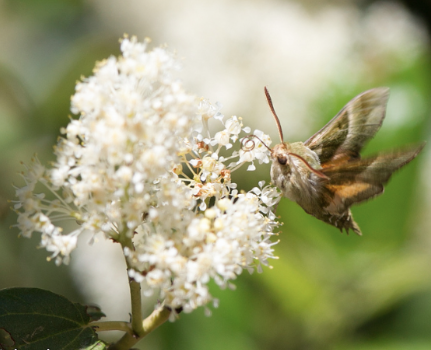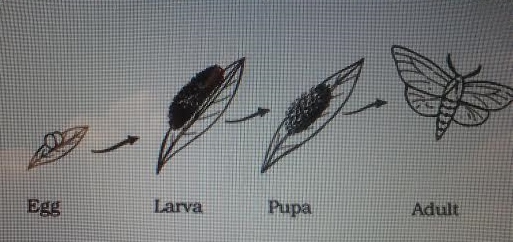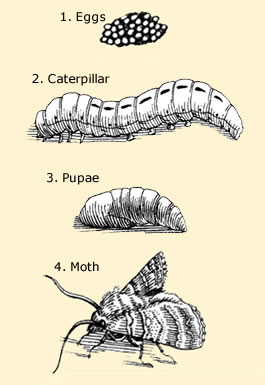Life History and Reproduction
 What is the life history and reproduction stages of
the Clark's Sphix moth?
What is the life history and reproduction stages of
the Clark's Sphix moth?
Life history is the stages of life and the different
steps that are undergone by an organism in its lifetime. Life
history is not only about the different stages, but the general
idea of natural selection and having the most possible offspring
survive.
Ova
An ovum is refered to as a female sex cell or gamete.
The ovum of the Proserpinus clarkiae is transparent,
round, and has a lime-green color to it. The size of these eggs
are EXTREMELY small. About a day before the ovum develops into a
larva, the ovum turns a yellowish color with a slight resemblance
of green (Buttererflies and Moths of North America 2014). An ovum
egg will hatch about ten days after it has been laid on its
host. As the caterpillars hatch, they eat the eggshells around
them.
Larva
When the moth finishes the ova stage, it then develops
into a larva. The color of the body is a yellowish-green color
now and instead of an anal horn; a pair of scoli takes over this
portion. The anal shield is unique because it is unlike any
other colors present in this organism. It goes from dark green
to a pinkish color (Osborne 1995).
Instead of
larva, this organism can be referred
to as a "hornroom" during this particular stage. The posterior end of the body has a narrow
tail that is almost hook-like that bends upwards (Zipcode
Zoo 2013). Boisduval (1852) had thought that
Proserpinus clarkiae nourished on
Onagraceae because of the Old World Proserpinus
proserpina (Pallas), mainly because this was well-known
during this man's time. "We have given to this species the name
of clarkiae by analogy, for we believe we can assure in
advance that is nourishes itself of a plant of the Oenotherae
family" (Boisduval 1852).
from dark green
to a pinkish color (Osborne 1995).
Instead of
larva, this organism can be referred
to as a "hornroom" during this particular stage. The posterior end of the body has a narrow
tail that is almost hook-like that bends upwards (Zipcode
Zoo 2013). Boisduval (1852) had thought that
Proserpinus clarkiae nourished on
Onagraceae because of the Old World Proserpinus
proserpina (Pallas), mainly because this was well-known
during this man's time. "We have given to this species the name
of clarkiae by analogy, for we believe we can assure in
advance that is nourishes itself of a plant of the Oenotherae
family" (Boisduval 1852).
Note that there are five instar stages between the larva and the
pupa. To find out more about these instar stages visit
this
multiple-author primary research article!
Pupa
The pupa stage could be commonly known as the "cocoon"
aspect of this organism. At this point, the pupa is twenty to
twenty-six millimeters in length and has a dark and light mixed
brown color (Osborne 1995). The outside of the pupa is smooth to the touch and
the abdominal side of the pupa has a larger indent. The pupa is
extremely cool because if the outside cocoon is touched, the
inside organism tends to occasionally move.
Adult
As an adult, the moth has grown bigger in size and is
characterized as a medium sized moth. The body of the Clark's
Sphinx is narrow and comes to a point near its end. At this
stage, the moth has developed wings! The wings are what helps
this moth to fly and the wings have a narrower shape to them. It
also has hind wings that are present that tend to be irregular
shaped and relatively smaller than the forewings. This moth has
no tympanal organ, which is referred
to as the hearing organ. This is extremely unique because most
organisms usually have this organ present. The antennae are
generally bigger in diameter towards the head. The further away
from the the head the antennae go, the narrower they get. The color of the moth at
this stage tends to be a greenish-gray color with bright orange
hind wings and sometimes the hind wings have a slight touch of
yellow. The hind wings also have black borders around them
(Butterflies and Moths of North America 2014).
tympanal organ, which is referred
to as the hearing organ. This is extremely unique because most
organisms usually have this organ present. The antennae are
generally bigger in diameter towards the head. The further away
from the the head the antennae go, the narrower they get. The color of the moth at
this stage tends to be a greenish-gray color with bright orange
hind wings and sometimes the hind wings have a slight touch of
yellow. The hind wings also have black borders around them
(Butterflies and Moths of North America 2014).
To find out more information about these stages and how
they progress over time, check out
this website! You will see images of the Clark's Sphinx
progressing in its different stages of life!
How does a Clark's Sphinx attract a mate?
Usually, one would attract a mate by appearance, but not for
the moths! They attract their mates by sense of smell if you can
believe that! This form of mating is not specifically for the
Clark's Sphinx Moth, but for the generalized group of moths. Due to
some of the dull colors that some moths have, mating tends to occur
at later periods of the night. The female moth is the one that tries
to attract the male. This is done by the production of
pheromones, which is a chemical substance
that tends to change the behavior of the same species (or in this
case, the opposite sex). The male will detect this scent with his
antennae and then he has a mate!
How does this organism reproduce?
A female moth can
mate with multiple moths before deciding to lay her eggs. When
mating, the moths link at the abdomen, and the male will use his
"claspers" which are located on their posterior end, in order to
keep in contact with the female. If a predator were to interrupt,
these "claspers" make it so that mating can continue while moving to
a safer location. The male moth emits what is known as
spermatophore through his penis that
carries sperm and nutrients to the soon to be developed larvae
(Evelyn 2008). What humans refer to as the uterus, a female moth
has a burse copulartrix, which is where
the males contribution is stored (Evelyn 2008). The eggs need to be
fertilized before release and then are placed on a host plant near a
food source. How awesome is that!?
Im sure you are wondering how the Proserpinus clarkiae
interacts with other moths and other organisms around them. Continue
onto the interactions page to find
out more information! Return to home page.